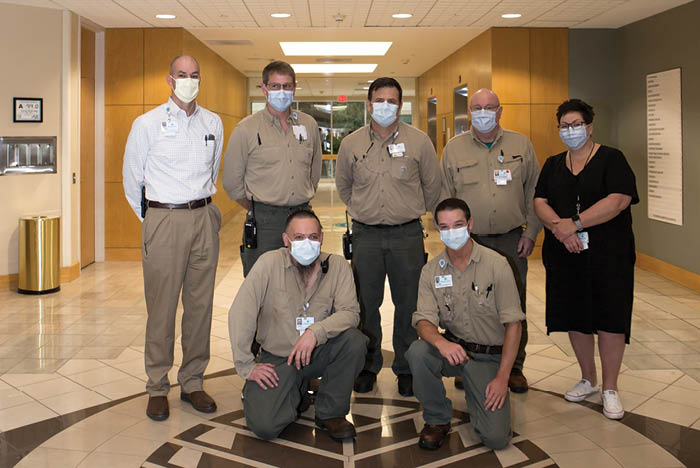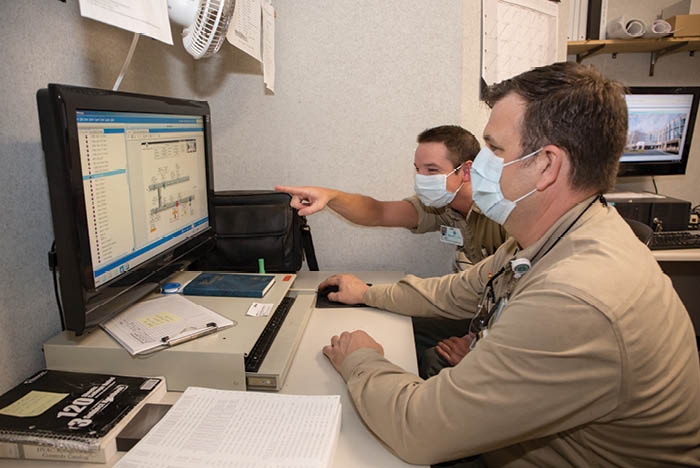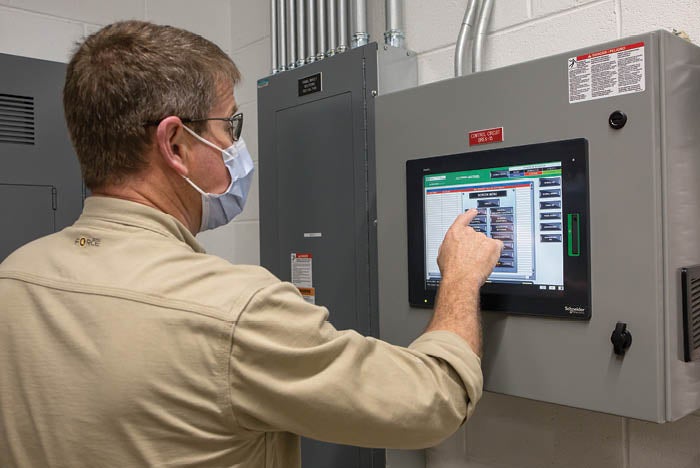Creating a culture of energy efficiency

TOP ROW, FROM LEFT: Brent Elks, manager of plant operations and maintenance (POM); Ronald Morehead, mechanic four for POM; Jody Hensley, mechanic four for POM; David Kitchener, mechanic two for POM; and Lisa Spearman, administrative assistant for POM. BOTTOM ROW, FROM LEFT: Joshua Hallman, supervisor for POM; and Tyler Roper, mechanic two for POM.
Photo by Kevin M. McCarthy
Atrium Health Cleveland, located in Shelby, N.C., and part of the Charlotte, N.C.-based Atrium Health system, was the recipient of the 2020 Energy to Care Energy Champion Award from the American Society for Health Care Engineering (ASHE).
The hospital facility received this award in recognition of significant energy-efficiency gains — the result of capital and operational investments, a committed plant operations and maintenance staff, and an organizational culture that brought together energy savings and patient care.
Energy accomplishments
Atrium Health Cleveland has made great strides in energy efficiency in the past decade. In 2011, its Environmental Protection Agency/Department of Energy ENERGY STAR® score was 2, and in August 2020, it achieved ENERGY STAR certification with a score of 77. A renewed focus on energy reduction, along with staff engagement and leadership support, has led to impressive outcomes.
Over the two-year period from January 2018 to December 2019, Atrium Health Cleveland’s energy consumption and costs decreased significantly. Monthly energy use at the facility dropped over 27%, from 11.7 million to 8.5 million kilo-British thermal units, and energy costs decreased over 25%, from $150,000 per month to $112,000. In addition, between 2018 and 2019, the energy cost avoidance — the cost savings resulting from energy management projects — increased by almost $365,000 compared to the 2012 baseline.
These energy-savings accomplishments were the result of a combination of capital and staff investments. An energy plant upgrade in 2018 contributed to the 19% decrease in energy use intensity by the end of the following year. The upgrade project included a 1,200-ton chiller, an 800-ton heat exchanger, three cooling towers and new sequences of operation to optimize the efficiency of the system.
Numerous additional operations improvements have helped boost the facility’s energy efficiency, including schedules and occupied/unoccupied set points in all non-acute spaces; tighter thermostat dead bands; discharge air temperature resets on all air-handling units (AHUs); heating water resets; lower plant steam pressure; lower AHU static pressure; balancing, calibration and repair of variable air volume boxes; AHU damper and valve control calibration; T8 LED lamp replacements; and installation of motion detectors.
The plant operations and maintenance team is supported by Atrium Health’s enterprise energy management team, which includes dedicated professionals specializing in building automation controls and energy monitoring. Joe Ross, director and senior service line leader at Atrium Health, says that the renewed focus on energy reduction was a way to put into action the energy-savings lessons learned from other facilities in the system. But, as Atrium Health Cleveland embarked on its journey, he also saw a chance to use new and creative approaches tailored to the facility that had the potential to yield significant results.
“We started on the ground floor and looked at each piece of equipment to see how we could make it more efficient,” Ross says. “Our strategy is to look at the facility needs, the opportunities and the available equipment and to think about how to make the most of what we have. For example, if a unit isn’t occupied 24/7, is there something we can do from a scheduling standpoint? For pneumatic controls, are there things we can do when the system is not in operation?”
Michael D. Roberts, PE, SASHE, CHFM, CHE, director of energy services and central energy plants at Atrium Health, says that addressing energy efficiency is a long-term process, and even small changes can bring substantial rewards. “Energy management is a journey and not a one-time thing that is put into place,” he says. “We didn’t let inefficient equipment stop us from moving forward with an energy-reduction program. The first energy project done at Atrium Health Cleveland did not address the central energy plant, which was aged and inefficient and needed to be replaced. Instead, we looked at a lot of other things, and the program was still very successful.”
Energy-savings culture
Energy management and efficiency have been a systemwide organizational objective for Atrium Health, and Roberts suggests that facilities managers think about energy management as part of a larger set of goals and responsibilities. “Our shared vision was ‘Atrium Health will be a recognized national leader in the transformation of health care energy performance and resilience to improve health, elevate hope and advance healing for all,’” he says. “Look at the mission of your organization, and see how an energy-savings program would tie into that mission.”

Jody Hensley (foreground), mechanic four, shows Tyler Roper, mechanic two, how to adjust fan speeds and valves to maintain patient comfort while saving energy on the hospital’s building automation system computer.
Photo by Kevin M. McCarthy
Ross describes the additional first steps that laid the foundation for Atrium Health Cleveland’s energy management program. “To help drive success, we set energy ground rules, the most important being that patients are always first,” he says. “We will not compromise Atrium Health’s values in terms of patient and staff safety, patient experience and comfort, and regulatory requirements. We will use energy wisely and efficiently when it’s needed but also look for ways to minimize or eliminate energy use when possible.”
Atrium Health Cleveland did not start with a major capital project and the goal to reduce consumption by a certain amount. Instead, the program developed through an organizational shift in the mindset around energy savings and ways to provide a safe and comfortable environment with available equipment. The plant operations and maintenance staff stepped up to this challenge by identifying opportunities that required minimal capital upfront.
The commitment of staff has been integral to Atrium Health Cleveland’s energy-efficiency success. High teammate engagement has helped integrate energy efficiency into the daily work of staff. As team members see progress, through metrics such as the ENERGY STAR Portfolio Manager and the ASHE Energy to Care Dashboard, they become even more invested in achieving operational excellence through energy efficiency.
“This team has always had a can-do spirit and a pride of ownership,” says Elizabeth Ratner, AIA, CEM, LEED AP BD+C, senior specialist at Atrium Health. “When they decided to really focus on energy efficiency, there was no stopping them. Everyone on the team participates in energy hunting and is always bringing new ideas to the table, no matter how large or small. This team doesn’t wait for energy-reduction goals to be set for them. Instead, they’re always looking for opportunities for incremental improvement.”
Ross also points to the time invested in understanding the passions and skill sets of team members to maximize their contributions to the program. “The energy successes at Atrium Health Cleveland are indicative of these efforts to evaluate the team,” he says. “The energy-savings results are just a manifestation of finding the right role for each person. People love what they do, and this facility has been very successful in this regard.”
This staff engagement reflects a broader shift in culture at Atrium Health Cleveland, where energy-efficiency efforts now reflect a collaborative process that involves leadership at all levels, facility administration, clinical staff and vendors. In addition, energy savings and patient care are no longer considered mutually exclusive goals. The focus instead is on providing high-quality patient care while also promoting energy-efficient operations.
The facility’s energy-savings efforts have resulted in improved occupant satisfaction and fewer complaints. In addition to the energy savings, the prolonged life span of equipment and the decrease in needed repairs have resulted in additional cost savings. Energy efficiency has supported patient care by providing funds for renovating clinical spaces, purchasing new equipment and offering more affordable hospital services to the community.
Energy Connect program
In 2016, Atrium Health launched the Energy Connect program, a partnership with the University of North Carolina at Charlotte, to provide advanced energy-efficiency training to plant operations and maintenance staff (see the second part of this cover story on page 22 for an in-depth look at the program). The program initially focused on establishing a knowledge baseline across all the Atrium Health sites by teaching 270 mechanics about the basics of energy efficiency and energy troubleshooting in health care facilities so that they could maintain existing savings and search for new opportunities.
Resources
The Energy Connect program later expanded and, in 2019, two Atrium Health Cleveland team members received over 50 hours of site-based training. These “Energy Performance Experts” now independently conduct energy troubleshooting and provide leadership on energy optimization, ongoing commissioning, and fault detection and resolution — in addition to engaging and encouraging their teammates (see sidebar on page 20).
“They are empowered to spot energy-savings opportunities, and they know how to address issues, who else to bring in and how to monitor changes over the long term,” Ratner says. “Many of the capital investments we make are definitive and easy to measure on an energy scorecard. This program is harder to measure, but the potential impact is limitless because it is driven by the proactiveness of the Energy Performance Experts at their site and their ability to inspire their teammates.”
Support from the senior leadership at both the facility and corporate levels has been critical to the success of the energy-efficiency program at Atrium Health Cleveland. The facility leadership supports the program by including it in the operating strategy of the hospital, offering assistance and resources, and publicly acknowledging the short- and long-term impacts of the program. At the corporate level, the leadership has made capital investments in facility upgrades, communicated its support of energy-efficiency efforts to the site leadership and staff, and regularly shared success stories with Atrium Health’s executive leadership.
This support started early on when the facilities management team first approached the leadership with a proposal to start with projects that required little capital and would demonstrate results. “They were able to present their ideas in a way that made sense to management, with hard data from the facilities and run rates that showed us the potential of these projects,” says Alex Bell, vice president and facility executive at Atrium Health. “It was clear what was achievable in a reasonable amount of time, and the results were trackable and measurable.”
Effective storytelling is key in advocating for an energy management program, Roberts says. “We have started every one of our presentations asking this question: How much do you think we spend on energy every second of every day, 365 days a year? And the answer to that is we were spending almost $1 a second. So, by the end of an hour-long presentation, we will have spent nearly $3,600 on energy.” He adds that addressing other issues of interest to leadership — energy rates and regulations, health risks, emergency management, and local and state initiatives — can help promote the support needed.
Bell believes that Atrium Health Cleveland’s achievements reflect a culture where the leadership provides support and encouragement and individual team members are invested in the organization. “There’s always an opportunity to move the ball ahead,” he says. “Recognize and value the input of staff, and take their ideas and implement them. Make sure that everyone in the department feels valued and that they can put their hands up. It should be an open-door policy from administration to facilities.”
Ratner agrees that the commitment from Atrium Health’s leadership has helped maintain the momentum of the energy management program. “All of the leaders, from the team manager up to the facility executive, prioritize recognition for this team and celebrate their accomplishments, which creates a great positive feedback loop,” she says. “We also acknowledge the efforts of the Energy Performance Experts as they go above and beyond their regular responsibilities every day to fulfill the energy-savings mission of the group.”
Continued energy savings
Atrium Health Cleveland reached three of its major energy goals last year when it received the ENERGY STAR certification, as well as ASHE’s Energy to Care Award and its Energy Champion Award.
By the end of December 2020, the facility had also reduced its energy consumption by another 6%.
These achievements are milestones in an evolving energy management program that strives to lower energy consumption year over year and seek out new opportunities to improve.
“We’ve always approached things from the bottom up and asked what we can do better today than yesterday,” Ross says. “The team is less concerned with a particular end goal. As a result, the hospital team is just as excited now as it was when our journey started.”
Camille N.Y. Fink is a freelance writer based in Oak Park, Ill.





